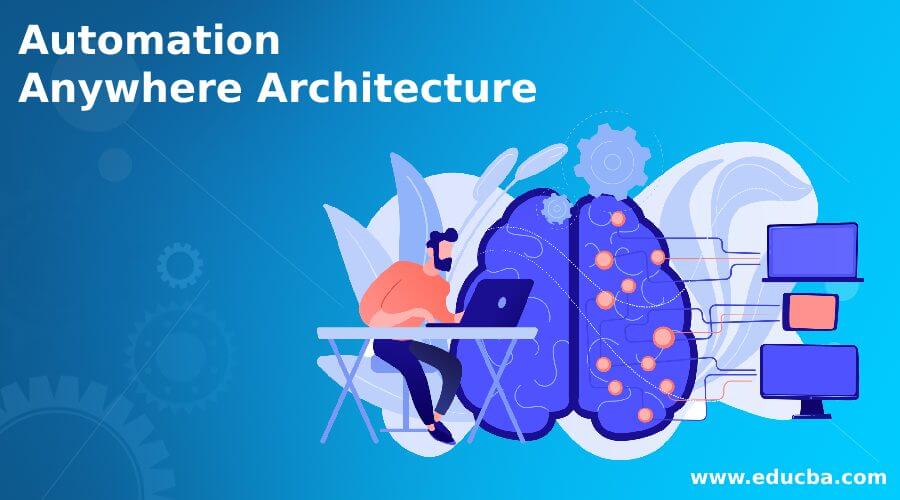Updated March 15, 2023
Introduction to Automation Anywhere Architecture
Automation anywhere architecture is defined as a collection of processes or rules that portrays the implementation of the systems of the automation anywhere tool. Automation anywhere is functionality along with a Robotic Process Automation tool that deals with easy to build and highly scalable software that enables mimic of human actions and based on the metaphorical software roots able to perform varied defined actions at a much faster rate and without much or very less errors. There are various RPA tools that enable automation of tasks as automation anywhere does, but this software particularly imparts better performance with flexibility to integrate with various platforms & scale at the same time.
Architecture of Automation Anywhere
Before we even start off with the architecture, we need to know the principle of architecture in automation anywhere is that of distributed architecture. In this type of architecture, there are different components which work synchronously and communicates over a network to attain the objective or goal.
This architecture has the following properties, and these are equally important for Automation Anywhere to inherit so that it can work according to the requirement and they are:
- The processing of information is not restricted to a single machine and is rather distributed over other computers on the network.
- The type of interaction that happens between the elements is of the type of client-server architecture and this client-server concept is the baseline to the formation of a multi-layer architecture.
- Variety of technology architectures are present that supports the distributed architecture and some of them are .NET, AXIS Java Web services, J2EE etc.
- The concept of middleware to provide a buffer between the application and network is the USP of the distributed architecture. This type of computer software is present in the middle of the system and enables management of the different elements in the distributed system and especially of that of the automation anywhere.
Due to its transparency, reliability and availability distributed architecture becomes the baseline principle for a lot of derived architecture.
Keeping the above-listed characteristics, we finally come to the architecture of automation anywhere tool which is described by the below diagram.
In the above diagram, we see that there are 3 elements that constitutes the automation anywhere architecture.
Now, let’s see each of the elements and see their roles in making the architecture into a distributed architecture standard.
1. Bot Creators
As a part of the development process, the automation in the automation anywhere tool is performed by a Bot, and this desktop application is present that is responsible for creating, editing and executing of the bots. This element is licensed for each of the bots and the system includes a run time for execution and testing of the bot. The desktop-based application has the authority of uploading and downloading bots.
Once the bots are configured, respective developers can access their corresponding bots and create their individual tasks and execute all of them at once as well. In terms of the distributed architecture, the bot creator acts as a client and hence needs to be connected to an active control room about which we will be focusing on in the next point.
2. Control Room
This element happens to be the most important component in the architecture. This happens to be the server in the terminology of a distributed architecture. The bots that are created by the bot creator is controlled by the control room and this element provides various features like centralized user management, bot farm, license management, dashboard reflecting the values for which the tool runs for and source control.
Talking specifically about licenses, this tool provides 2 types of licenses as a part of the accessor to segregate who can access or who can edit. Dev license is given to users who needs to create or develop and run a bot, whereas run license is given to the users who only need to run the bots and not necessarily create them. Control room schedules and assigns bots for the execution of the tasks.
3. Bot Runners
Till now we have created a bot and also set up the room from there the execution will be handled, but in order to complete we would need this point with as much importance as that of the previous 2. The last element of the automation anywhere tool is to accomplish the task of running a bot. Here, these element helps in running the bots and if required they can be run parallelly as well. There is no chance that this element can create or update a bot.
This element is a run time client that is installed in the windows system that executes the bot that is created by the Bot creator and commanded by the control room and then reports backs the log of the execution along with the status back to the control room for audit purposes. The only requirement in terms of Bot Runners is that it needs to be registered and authenticated along with being identifiable by the control room in order to run the job which would provide the desired output. Another interesting feature of bot runner is its possibility of grouping and then dynamically allocated which gives a convenient opportunity to the users to scale up the system.
Conclusion
With this, we come to the conclusion and understanding the different elements that constitute the automation anywhere tool. We also gathered the information that architecture that governs the automation anywhere tool is that of the distributed architecture and different elements we went through explains the reason for the same.
Recommended Articles
This is a guide to Automation Anywhere Architecture. Here we discuss the introduction and architecture of automation anywhere. You may also have a look at the following articles to learn more –




